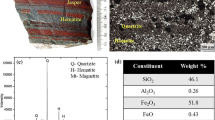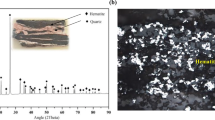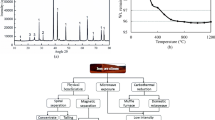Abstract
The current study investigates the beneficiation of iron ore fines by the carbothermal process using muffle and microwave furnace. The muffle furnace reduction was found useful for the separation of iron-bearing phases from the quartz impurities and concentrate with iron purity of ~ 64%, recovery of 98%, and a yield of 84.5% is achieved at 900 °C, 9% charcoal in 1 h. Incorporating coal as a reductant followed a similar trend as charcoal, although the leaner reduction rate leads to limited fayalite formation and, consequently, better magnetic property at a higher temperature. The microwave exposure of ore led to a temperature of ~ 750 °C in 15 min, and the ore-reductant mixture attained 960 °C with charcoal and ~ 800 °C with coal. The microwave reduction yielded comparable concentrate iron grade-recovery with muffle furnace reduction at comparatively lower carbon dosage (6%), suggesting better carbon utilization. Meanwhile, coal-based microwave reduction followed the opposite trend as muffle furnace reduction, and iron grade decreases with an increase in carbon dosage. The optimal conditions of 6% charcoal and 800 W yielded concentrate of 63.8% Fe, 99% recovery with 87.4% product yield. The maximum separation efficiency of the muffle furnace reduction is 80% at 1000 °C with 18% charcoal compared to 70% in the microwave at 6% charcoal, indicating the latter route is efficient and economical. The separation efficiency remains unaltered with carbon dosage suggesting minimal carbon required for achieving maximum separation is 6% C. The metallization of the product of microwave reduction was the functionality of reductant dosage and increases exponentially with carbon dosage. The ferrite formation is initiated at 12% C with maximum metallization of 38.5% at 27% charcoal and 900 W power. The maximum metallization in muffle furnace reduction is 16% at 1000 °C and 18% C. The techno-economic comparison indicates incorporating microwave reduction reduces processing time by 25%, and the carbon consumption is reduced by 35.5%.
Graphical Abstract













Similar content being viewed by others
References
National steel policy, Ministry of Steel, Government of India (2017). https://steel.gov.in/sites/default/files/draft-national-steel-policy-2017.pdf. Accessed 22 Feb 2020
Das B, Rath SS (2020) Existing and new processes for beneficiation of Indian iron ores. Trans IIM. https://doi.org/10.1007/s12666-020-01878-z
Singh S, Sahoo H, Rath SS, Sahu A, Das B (2015) Recovery of iron minerals from Indian iron ore slimes using colloidal magnetic coating. Powder Technol 269:38–45
Sunil S, Rayapudi V, Dhawan N (2020) Recovery of iron values from discarded iron ore slimes. Miner Metall Explor 37(1):287–295
Rayapudi V, Agrawal S, Dhawan N (2019) Microwave-assisted carbothermal reduction of banded hematite jasper ore. J Sustain Metall 5:528–537. https://doi.org/10.1007/s40831-019-00244-8
Rayapudi V, Agrawal S, Dhawan N (2019) Optimization of microwave carbothermal reduction for processing of banded hematite jasper ore. Miner Eng 138:204–214
Omran M, Fabritius T, Mattila R (2015) Thermally assisted liberation of high phosphorus oolitic iron ore: a comparison between microwave and conventional furnaces. Powder Technol 269:7–14
Agrawal S, Rayapudi V, Dhawan N (2019) Comparison of microwave and conventional carbothermal reduction of red mud for recovery of iron values. Miner Eng 132:202–210
He G, Qu W, Zhang L et al (2020) Effects of sodium peroxide additives on dielectric properties and microwave roasting mechanism of zinc sulfide concentrate. JOM 72(5):1920–1926. https://doi.org/10.1007/s11837-020-04050-6
Amini A, Ohno K, Maeda T (2018) Effect of the ratio of magnetite particle size to microwave penetration depth on reduction reaction behaviour by H2. Sci Rep 8(1):1–7
Rath SS, Sahoo H, Dhawan N, Rao D, Das B, Mishra BK (2014) Optimal recovery of iron values from a low grade iron ore using reduction roasting and magnetic separation. Sep Sci Technol 49(12):1927–1936
Rayapudi V, Dhawan N (2019) Microwave processing of banded magnetite quartzite ore for iron recovery. Trans IIM 72:1697–1705
Tavares LM, King RP (1999) Evaluation of thermally-assisted fracture of particles using microscale fracture measurements. KONA Powder Par J 17:163–172
Wills B, Finch J (2015) Wills' mineral processing technology: an introduction to the practical aspects of ore treatment and mineral recovery. Butterworth-Heinemann, Oxford
Makhija D, Mukherjee AK, Ghosh TK (2013) Preconcentration feasibility of gravity and magnetic techniques for banded hematite jasper. Int J Min Eng Miner Process 2:8–15
Han H, Duan D, Yuan P, Chen S (2015) Recovery of metallic iron from high phosphorus oolitic hematite by carbothermic reduction and magnetic separation. Ironmak Steelmak 42(7):542–547
Mishra S, Roy GG (2016) Effect of amount of carbon on the reduction efficiency of iron ore-coal composite pellets in multi-layer bed rotary hearth furnace (RHF). Metall Mater Trans B 47(4):2347–2356. https://doi.org/10.1007/s11663-016-0666-1
Harrison P (1997) A fundamental study of the heating effect of 2.45 GHz microwave radiation on minerals (Doctoral dissertation, University of Birmingham)
Lester E, Kingman SW, Dodds C, Patrick J (2006) The potential for rapid coke making using microwave energy. Fuel 85:2057–2063
Williams O, Ure A, Stevens L et al (2019) Formation of metallurgical coke within minutes through coal densification and microwave energy. Fuel 33(7):6817–6828
Hara K, Hayashi M, Sato M, Nagata K (2011) Continuous pig iron making by microwave heating with 125 kW at 245 GHz. J. Microwave Power Electromag Energy 45(3):137–147
Indian Bureau of Mines, Monthly Statistics of Mineral Production Jan. issue (2020). https://mines.gov.in/writereaddata/UploadFile/ASPmineralsJanuary08042020.pdf. Accessed: 24 April 2020
Acknowledgements
The authors acknowledge the Science Engineering Research Board, New Delhi, for providing funds under the Early Career Research Grant, ECR-000874-2016. Thanks are also due to Prabal Modi and Veeranjaneyulu Rayapudi for their assistance in preliminary experiments.
Author information
Authors and Affiliations
Corresponding author
Additional information
The contributing editor for this article was Sharif Jahanshahi.
Publisher's Note
Springer Nature remains neutral with regard to jurisdictional claims in published maps and institutional affiliations.
Rights and permissions
About this article
Cite this article
Agrawal, S., Dhawan, N. Carbothermic Microwave Processing for the Enrichment of Iron Ore Fines. J. Sustain. Metall. 6, 355–366 (2020). https://doi.org/10.1007/s40831-020-00279-2
Published:
Issue Date:
DOI: https://doi.org/10.1007/s40831-020-00279-2




